View in other NatureServe Network Field Guides
NatureServe
Montana
Utah
Wyoming
Idaho
Wisconsin
British Columbia
South Carolina
Yukon
California
New York
Large Fringe-cup - Tellima grandiflora
Native Species
Global Rank:
G5
State Rank:
S3S4
(see State Rank Reason below)
C-value:
7
Agency Status
USFWS:
USFS:
BLM:
External Links
State Rank Reason (see State Rank above)
Tellima grandiflora occurs in northwestern Montana. Plants grow in mesic coniferous forests from low to high elevations and often near streams. Populations are typically small and localized, though some sites are known to support several hundred plants. Populations are also frequently found near established game or hiking trails. While plants may be uncommon its habitat appears to be widespread and relatively secure, and threats have not been identified. Current data on population sizes, viability, habitat condition, and threats is needed.
- Details on Status Ranking and Review
Range Extent
ScoreE - 5,000-20,000 sq km (~2,000-8,000 sq mi)
Comment9,649 square kilometers.
Area of Occupancy
ScoreD - 6-25 4-km2 grid cells
CommentMontana can be divided into 30,390 4x4 square kilometer cells. For this species plant observations occur in 15 of these 4x4 square kilometer cells.
Number of Populations
ScoreB - 6 - 20
Comment19 observations.
Environmental Specificity
ScoreB - Narrow. Specialist or community with key requirements common
CommentCoefficient of Conservatism value is 7 indicating plants require a somewhat narrow range of ecological conditions and does not tolerate disturbance.
Threats
ScoreD - Low
CommentThreats have not been observed. Impacts from timber harvests have not been brought forth.
General Description
PLANTS: Perennial forbs from a horizontal rootstock. Stems are erect, hirsute below, glandular above, and 40–70 cm tall. Source: Lesica et al. 2012.
LEAVES: Basal and alternately arranged on the stem, and sparsely hairy. Lower leaves have petioles and blades that are cordate-orbicular in shape, 5- to 7-lobed with dentate margins, and 3–12 cm wide. Upper leaves are smaller and sessile (lack petioles). Source: Lesica et al. 2012.
INFLORESCENCE: A narrow, glandular raceme. Flowers are 5-merous, regular, and perfect. Calyx is cup-shaped, 6–8 mm long, and has erect lobes. Petals are white to reddish, 4–6 mm long with 5 to 7 thread-like lobes at the tip. Stamens are 10. Pistil is inferior, but less than half of it is fused with the hypanthium. Fruit is a capsule. Capsule is 6–8 mm long with numerous seeds. Source: Lesica et al. 2012.
Species Range
Montana Range
Range Descriptions
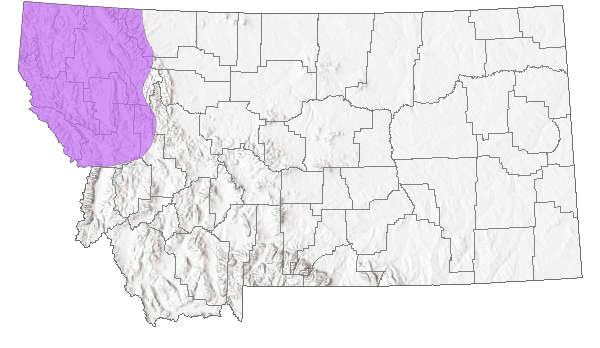
 Native
Native
Range Comments
Alaska south to California, Oregon, Idaho, and Montana (Lesica et al. 2012). In Montana plants have been found in Flathead and Lincoln counties (Lesica et al. 2012).
Observations in Montana Natural Heritage Program Database
Number of Observations: 29
(Click on the following maps and charts to see full sized version)
Map Help and Descriptions
Relative Density
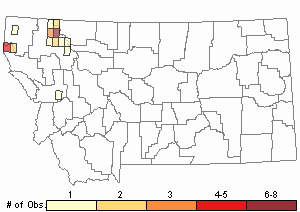
Recency
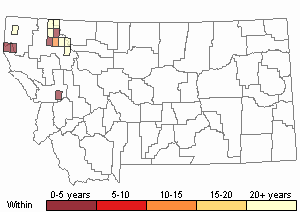
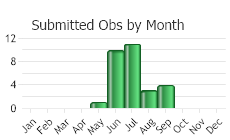
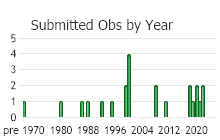
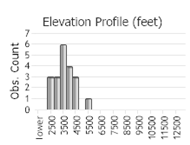 (Observations spanning multiple months or years are excluded from time charts)
(Observations spanning multiple months or years are excluded from time charts)
Habitat
Moist forest soils along streams in the montane zones of Montana (Lesica et al. 2012).
Stewardship Responsibility
References
- Literature Cited AboveLegend:
 View Online Publication
View Online Publication Lesica, P., M.T. Lavin, and P.F. Stickney. 2012. Manual of Montana Vascular Plants. Fort Worth, TX: BRIT Press. viii + 771 p.
Lesica, P., M.T. Lavin, and P.F. Stickney. 2012. Manual of Montana Vascular Plants. Fort Worth, TX: BRIT Press. viii + 771 p.
- Additional ReferencesLegend:
 View Online Publication
View Online Publication
Do you know of a citation we're missing? Lesica, P., M.T. Lavin, and P.F. Stickney. 2022. Manual of Montana Vascular Plants, Second Edition. Fort Worth, TX: BRIT Press. viii + 779 p.
Lesica, P., M.T. Lavin, and P.F. Stickney. 2022. Manual of Montana Vascular Plants, Second Edition. Fort Worth, TX: BRIT Press. viii + 779 p.
- Web Search Engines for Articles on "Large Fringe-cup"





